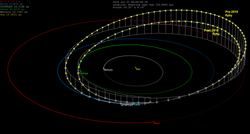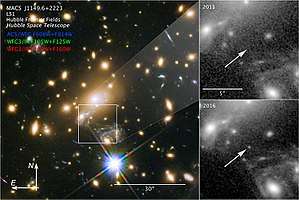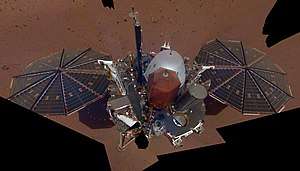2018 PD20
2018 PD20 is a small asteroid, classified as a near-Earth object of the Apollo group, approximately 9–20 meters (30–66 feet) in diameter. On 11 August 2018, it was first observed by ATLAS at the Mauna Loa Observatory on Hawaii (T08),[1] when it passed 33,500 kilometers (20,800 miles) from the Earth.[4] This is notable because it came within a tenth of the lunar distance, or 0.10 LD which is closer to Earth than satellites in a geostationary orbit. These have an altitude of 0.11 LD, about 36,000 km (22,000 mi), approximately 3 times the width of the Earth.
 Orbit and positions of 2018 PD20 | |
| Discovery [1] | |
|---|---|
| Discovered by | ATLAS-MLO |
| Discovery site | Mauna Loa Obs. (first observed only) |
| Discovery date | 11 August 2018 |
| Designations | |
| 2018 PD20 | |
| A107ZJi [2][3] | |
| NEO · Apollo [1][4] | |
| Orbital characteristics [4] | |
| Epoch 23 March 2018 (JD 2458200.5) | |
| Uncertainty parameter 7[4] · 6[1] | |
| Observation arc | 1 day |
| Aphelion | 1.6604 AU |
| Perihelion | 0.8163 AU |
| 1.2383 AU | |
| Eccentricity | 0.3408 |
| 1.38 yr (503 d) | |
| 300.72° | |
| 0° 42m 54.72s / day | |
| Inclination | 9.4808° |
| 317.68° | |
| 283.56° | |
| Earth MOID | 0.000182 AU (0.0708 LD) 27191 km |
| Physical characteristics | |
Mean diameter | 9 m (est. at 0.24)[5] 20 m (est. at 0.05)[5] |
| 27.38[4] 27.4[1] | |
Orbit and classification
2018 PD20 orbits the Sun at a distance of 0.82–1.66 AU once every 17 months (503 days; semi-major axis of 1.24 AU). Its orbit has an eccentricity of 0.34 and an inclination of 9° with respect to the ecliptic.[4]
The asteroid has an Earth minimum orbital intersection distance of 0.000181761 AU (27,191 km), which translates into 0.078 lunar distances.[4]
References
- "2018 PD20". Minor Planet Center. Retrieved 7 September 2018.
- "Previous NEO Confirmation Page Objects". Minor Planet Center. Retrieved 7 September 2018.
- "Pseudo-MPEC for A107ZJi". www.projectpluto.com. Archived from the original on 20 August 2018. Retrieved 21 August 2018.
- "JPL Small-Body Database Browser: (2018 PD20)" (2018-08-12 last obs.). Jet Propulsion Laboratory. Retrieved 7 September 2018.
- "Asteroid Size Estimator". CNEOS NASA/JPL. Retrieved 7 September 2018.
External links
- Closest asteroid flyby of the year: 2018 PD20 flew past Earth at 0.09 LD
- MPEC 2018-P79 : 2018 PD20
- 2018 PD20 at NeoDyS-2, Near Earth Objects—Dynamic Site
- Ephemeris · Obs prediction · Orbital info · MOID · Proper elements · Obs info · Close · Physical info · NEOCC
- 2018 PD20 at the JPL Small-Body Database

